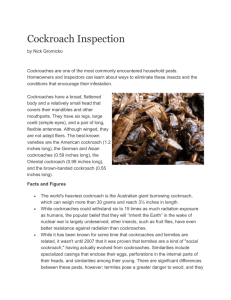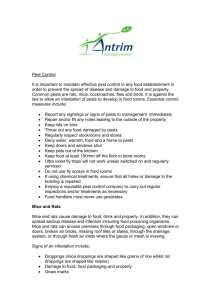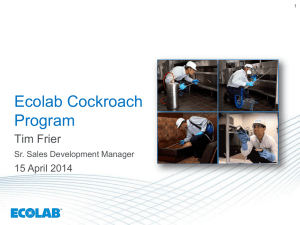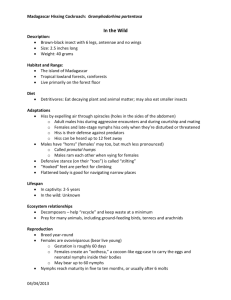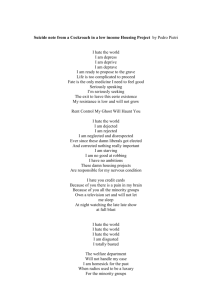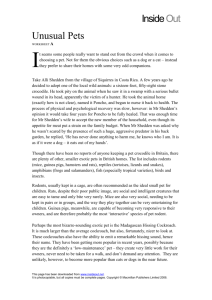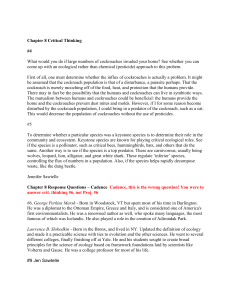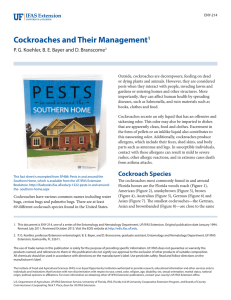Cockroach brochure - Flick Pest Control
advertisement
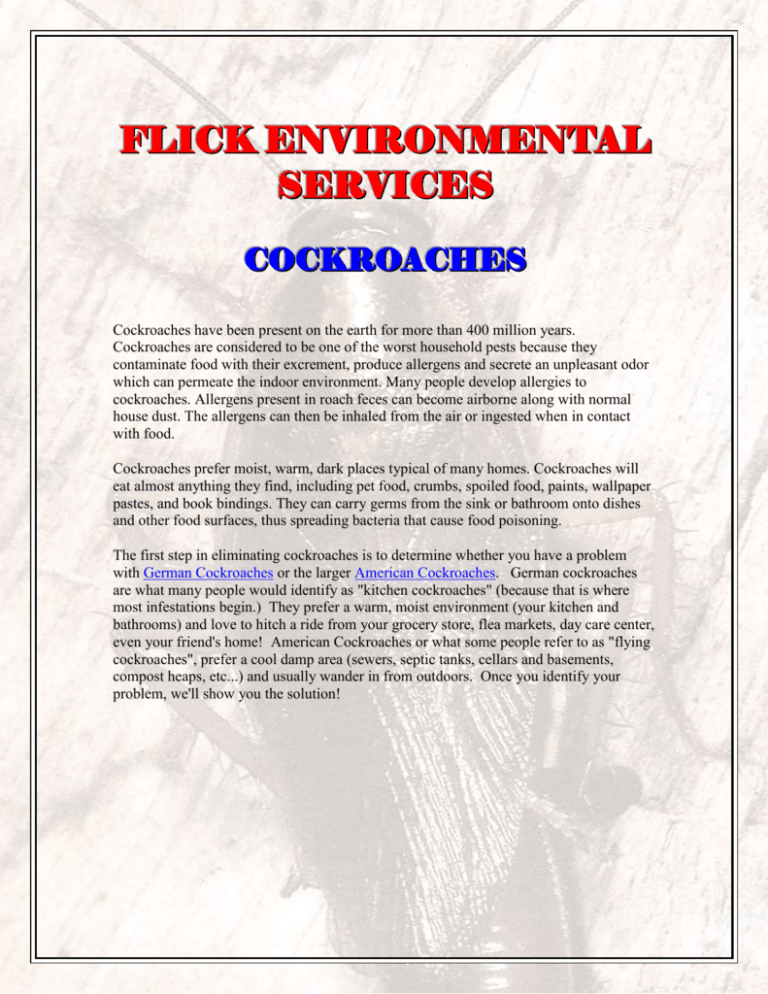
1 FLICK ENVIRONMENTAL S E R V IC E S COCKROACHES Cockroaches have been present on the earth for more than 400 million years. Cockroaches are considered to be one of the worst household pests because they contaminate food with their excrement, produce allergens and secrete an unpleasant odor which can permeate the indoor environment. Many people develop allergies to cockroaches. Allergens present in roach feces can become airborne along with normal house dust. The allergens can then be inhaled from the air or ingested when in contact with food. Cockroaches prefer moist, warm, dark places typical of many homes. Cockroaches will eat almost anything they find, including pet food, crumbs, spoiled food, paints, wallpaper pastes, and book bindings. They can carry germs from the sink or bathroom onto dishes and other food surfaces, thus spreading bacteria that cause food poisoning. The first step in eliminating cockroaches is to determine whether you have a problem with German Cockroaches or the larger American Cockroaches. German cockroaches are what many people would identify as "kitchen cockroaches" (because that is where most infestations begin.) They prefer a warm, moist environment (your kitchen and bathrooms) and love to hitch a ride from your grocery store, flea markets, day care center, even your friend's home! American Cockroaches or what some people refer to as "flying cockroaches", prefer a cool damp area (sewers, septic tanks, cellars and basements, compost heaps, etc...) and usually wander in from outdoors. Once you identify your problem, we'll show you the solution! 1 2 GERMAN COCKROACH ELIMINATION To exterminate German Cockroaches we recommend you use either the clean-out method or baiting method. Clean-out Method: The pesticides used in a clean-out will also exterminate many other pests in homes, restaurants or other businesses. A cockroach clean out is usually implemented in locations where there is a very large cockroach population or when the cockroaches in the area have been identified as a group of cockroaches that are resistant to insecticides. The clean-out procedure involves: 1) Residual pesticides: Spraying baseboards, underneath and behind appliances and in other areas where cockroaches frequent gives you the long term control that you need. 2) Crack & crevice work: When dealing with a severe infestation, a residual pesticide alone will not exterminate the entire cockroach population. Using professional aerosols and/or dusts enables one to inject pesticides into the tiny areas where your target pests are hiding. This also helps to "flush out" pests, forcing them to enter areas you have treated with residual products. For flushing action without a residual (for more sensitive areas, food handling appliances, etc.,) Pyrethrin Aerosols are the best. 3) Baiting Method: The best professional cockroach bait on the market today is Maxforce Gel. This product is applied from a large syringe, making applications simple and effective. The gel formulation enables you to place the material into cracks and crevices, appliances, pictures or clocks, in the corners of cabinets or any place where you suspect cockroaches are hiding. Each cockroach feeding on Maxforce will kill up to 40 other cockroaches via droppings and dead bodies. This "secondary kill" has a domino effect, eliminating up to ten generations of cockroaches with one simple application! 2 3 LARGER COCKROACH EXTERMINATION There are several species of larger cockroaches (including American Cockroach, Brown banded Cockroach, Smoky Brown Cockroach, Oriental Cockroach) that are most often found outdoors but invade your home and become a major pest. They breed in any type of mulch (pine straw, bark, and leaves), dead trees, wood piles or other organic material. Their harborage can also include sewers, landscape timbers, basements, driveway walls and attics. To exterminate larger cockroaches, the following control methods would be used: Outside Spraying: Using a good residual spray, the garden area all the way around the house and one foot up the foundation wall will be sprayed. The pesticide will be applied to entry points such as windows, doors, plumbing and vents. Spraying harborage areas such as rain gutters, hollow trees, mulch, tool sheds and retainer walls will complete the outdoor treatment. Inside Spraying: Spraying the inside where the cockroaches have been seen, paying special attention to areas where there is water. This includes the refrigerator, air conditioner, dishwasher, freezer, garage, laundry room and all plumbing. Dusting: Dusts enables one to apply products in areas where insects are most likely to hide but where pets and humans are least likely to come in contact. Using these products in voids where cockroaches may hide or travel is an excellent pest management tool, killing many pests in the areas where spraying is difficult or hard to reach. Gel baiting: In sensitive areas where one should avoid the use of contact pesticides, such as food handling premises or manufacturing companies, the use of professional gel bait such as Maxforce will be used to eliminate cockroaches. 3 4 Control cockroaches by using several control methods at the same time. These include: cut off food and water sources eliminate cockroach hiding places Use pest control products. (as per above clean-out procedure) Cut off Food & Water Sources Wipe off your kitchen counters and dining room table (or any other place where you eat) after every meal or snack. Don't leave dirty dishes on the kitchen counter overnight. If you need to soak a pot overnight, make sure it's filled with hot, soapy water. If you need to leave dishes overnight, rinse them first. If you use a dishwasher, make sure you don't leave dirty dishes in it overnight. Wipe any grease off the stove top and burners every night. Clean up all food spills promptly, especially on carpets and furniture. Garbage and compost should be kept in containers with lids and disposed of as often as possible. If your bathroom has a fan, use it after every bath or shower to reduce humidity. Keep all foods stored in kitchen cupboards in sealed containers. Put store-bought foods packaged in paper or plastic bags (such as sugar, flour, rice and cookies) in glass jars or plastic containers with tight lids. Vacuum and sweep your home regularly to help remove bits of food. Regularly clean the inside of your oven and the air vent (fume hood) above your stove to remove grease. Regularly check toilets and water faucets for leaks and make sure there are no leaks in the plumbing underneath the kitchen or bathroom sink. Empty your dog's or cat's food and water bowls at night and fill again in the morning. Wash pet food dishes daily. Eliminate Cockroach Hiding Places After depriving cockroaches of food and water, reduce the number of hiding places they need for shelter in your home. Cockroaches like tight, small places. Try to remove as much clutter as you can. Don't stuff paper or plastic bags in the space between your refrigerator and a kitchen cupboard. Store them in a cupboard or drawer away from the kitchen or bathroom. Keep cupboards as tidy as possible, without a lot of clutter, so cockroaches don't have narrow, dark places to hide. Use the narrow crevice attachment that comes with your vacuum cleaner to suck cockroaches out of cracks, from under your refrigerator and stove, from cupboards and off furniture. Hard-to-clean areas are probably the main sources of a cockroach problem. Pull out refrigerators, stoves and freezers, and clean behind, beside and under them once monthly. Wash the outside of kitchen appliances and vacuum dusty areas around motors, such as at the back of the refrigerator. Seal holes in walls around plumbing and electrical lines between apartment units. Seal cracks and crevices in cupboards and walls. If you own your home, you can do structural improvements yourself or hire someone to do them. If you rent, talk to your landlord or building supervisor. One of the most important things to do is to seal up the many cracks and crevices in the typical house or apartment. These are the tiny "doorways" that cockroaches use to get into their dark hiding places behind the walls. If they can't get there, they can't keep breeding. 4 5 5

